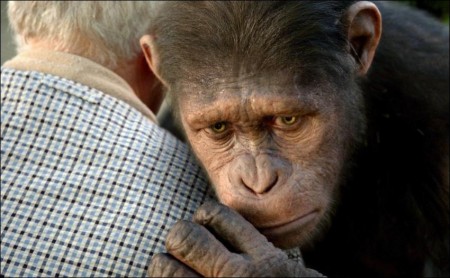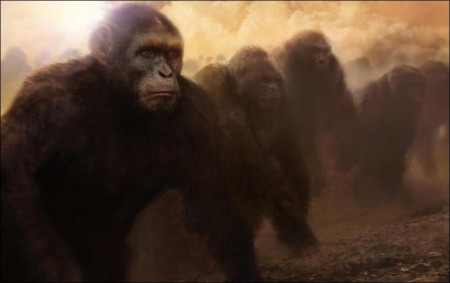Taglines: Evolution becomes revolution.
“Rise of the Apes” is a completely new take on one of 20th Century Fox’s most beloved and successful franchises. Oscar-winning visual effects house Weta Digital – employing certain of the groundbreaking technologies developed for “Avatar” – will render, for the first time ever in the film series, photo-realistic apes rather than costumed actors.
“Rise of the Apes” is an origin story in the truest sense of the term. Set in present day San Francisco, the film is a reality-based cautionary tale, a science fiction/science fact blend, where man’s own experiments with genetic engineering lead to the development of intelligence in apes and the onset of a war for supremacy.
Introduction
“Rise is the Planet of the Apes” is the first live-action film in the history of movies to star, and be told from the point of view of, a sentient animal — a character with human-like qualities, who can strategize, organize and ultimately lead a revolution, and with whom audiences will experience a real emotional bond. The film was impossible to make until the technology, invented for Avatar and now advanced to a new dimension, caught up to the idea behind the movie.
This work is complemented by the unique and extraordinary achievements of Andy Serkis, the world’s foremost performance capture actor, who infuses Caesar with nuance, soul, wisdom and heart.
Another historic accomplishment for the picture was its filming of visual effects and performance capture work on practical locations outside the controlled environment of an enclosed stage. This allowed the performance capture work to be fully integrated with the live action performances — eliminating the barrier between visual effects and live action.
In addition to presenting emotionally-engaging photo-realistic apes, the film’s setting is instantly recognizable and relatable. “Rise is the Planet of the Apes” is an origin story in the truest sense of the term. Set in present day San Francisco, the film is a reality-based cautionary tale, a science fiction/science fact blend, where man’s experiments with genetic engineering lead to the development of intelligence in apes and the onset of a war for supremacy.
“This is a contemporary view of the Planet of the Apes mythology,” says producer Dylan Clark. “It’s a big event movie, but is anchored by the quality of its storytelling, its emotion, and the depth of its characters. At its heart, it’s a character-driven piece.”
The film’s emotional core was a principal draw for the actors, including John Lithgow. “It’s very unusual to have a big science fiction film with a foundation in human emotion and conflict,” says the Oscar nominated actor. “I was amazed by the script’s emotional authenticity. This film takes audiences’ expectations and turns them on their head.”
Much like its storied predecessor, the original Planet of the Apes, the new film uses the science fiction genre to explore bigger worlds and ideas. “Rise is the Planet of the Apes is about our civilization reaching a point of no return,” says director Rupert Wyatt. “Events unfold through the eyes of Caesar, a super-intelligent chimpanzee who at a young age sees humans as being capable of wonderful things, like art and reason. And then he begins to see humanity’s dark side – oppression, bigotry, and the ostracizing of what and who we don’t understand.”
Another key theme is humanity’s hubris – our arrogance in thinking that we can twist, push, cheat, or circumvent the laws of nature, without consequences. “In the original Planet of the Apes, it was man’s hubris that got the character of Col. Taylor [portrayed by Charlton Heston] on that beach, facing the Statue of Liberty and the stunning reality of humanity’s destiny,” writer-producer Rick Jaffa points out. “It wasn’t a quirk of fate or a mutation that that led to that upside-down world.” So, too, does “Rise is the Planet of the Apes” pit humans against nature – and against themselves – leading to a resolution that sees humans and apes on the path that will take them to a new and shocking world order.
Gen-Sys: In The Beginning
Will Rodman (James Franco) is a scientist working within a large pharmaceutical corporation, Gen-Sys, conducting genetic research to develop a benign virus that restores damaged human brain tissue. He is committed to finding a cure for Alzheimer’s, a disease that afflicts his father, Charles (John Lithgow). Will’s relentless focus – “he’s married to his science,” says Jaffa – has precluded personal relationships, but the connection between his research and Charles’ illness brings the two together, albeit under difficult heart-rending circumstances. “Will is a cold, isolated person,” says James Franco, a recent Best Actor Oscar-nominee for his work in 127 Hours. “Most of his energy is directed towards his work. His father, Charles, is suffering from dementia so he moves into his father’s house, which was once Will’s childhood home, to take care of him. Being a caregiver is a role Will has never had to perform before.”
Just prior to Gen-Sys’ commencement of human trials of a promising and potentially lucrative new drug, ALZ-112, Will’s simian test subjects suddenly display bizarrely aggressive behavior. Management deems the research a failure and Will must shut down his program.
Amidst the confusion of the study’s sudden termination, Will finds himself charged with an overlooked newborn infant chimpanzee – a male, the newly orphaned offspring of his most promising test subject. That young chimp, destined for greatness, is named Caesar.
Bringing Caesar To Life
In creating Caesar and the world he inhabits, Weta Digital’s mandate, as it was on Avatar and the Lord of the Rings trilogy, is to take audiences to worlds never seen before. “Rise is the Planet of the Apes” senior visual effects supervisor Joe Letteri, a four-time Oscar winner, explains: “For Avatar, Jim Cameron created a complete fantasy world that no one had ever experienced before. The challenge with RISE OF THE PLANET OF THE APES was a very different one, and in some ways, it was even more daunting. We applied some of the technology we developed for Avatar to create a real, recognizable world – modern-day San Francisco. Everything – the apes, the locations – had to feel genuine because we’re exploring a story that’s reality-based and not straight-ahead science fiction.”
Letteri credits Rupert Wyatt for championing the notion of a reality-based story and effects. “Rupert has instilled the overall idea in all of us that we are bringing realistic-looking chimps into the mix. So, we started at ground zero. It’s a fresh new approach to the Planet of the Apes film series. We’re presenting primates as we know them. We’re giving them an additional level of intelligence and subtle human tendencies.”
For Letteri, Planet of the Apes is in some ways the Holy Grail for visual effects artists, because the 1968 original is a cinema touchstone for both its spectacle and themes. “For me,” says Letteri, “Planet of the Apes is such a classic and beloved film that the idea of working on an origin story – the story about how it all came to be – was interesting, especially being able to focus on the point of view of Caesar as our main character.”
As Weta Digital utilized its state-of-the-art tools to render photo-realistic apes, the world’s foremost performance capture artist, actor Andy Serkis, came aboard the project to infuse Caesar with nuance, emotion, soul, wisdom and heart. Serkis’ contributions to RISE OF THE PLANET OF THE APES cannot be overestimated, says Wyatt: “Andy Serkis is our generation’s Charlie Chaplin. By that I mean he’s one of the very few actors around who has fully embraced the available visual effects technology because he completely understands the full potential of what it can achieve. I think some actors are intimidated by performance capture because they think it’s separating their performance from the actual reality of the film, when quite the opposite is true. Andy understands that every little nuance – every breath, every little muscle movement that he gives on camera is visual exposition. Film is primarily a visual medium and if you are able to have your character tell a story with a minimal amount of words, then that’s ideal.”
Caesar’s character arc takes the chimp from a newborn to an adult and the leader of a revolution. Serkis, who gave acclaimed performances as Gollum in the Lord of the Rings trilogy, and as Kong in King Kong, notes that “Caesar is one of the most formidable roles I’ve undertaken, both physically and emotionally. It’s one thing to play a chimpanzee, but to play one from infancy to adulthood – and a revolutionary leader – well, that’s quite another. But it was irresistible to me as an actor.
“Part of the journey is having played him as a toddler and the joy of discovery and then realizing that he has this intelligence beyond his years,” Serkis continues. “He’s picking up on human beings around him and is sensing that he is an extraordinary gifted being and then realizing that the world can be a very brutal place. Caesar has intelligence foisted on him. He didn’t seek it out. There’s a lot of responsibility on his shoulders, without him having asked for it.” By the film’s second act, “Caesar becomes a prisoner,” says Serkis. “He gets taken away from a loving environment and feels rejected. He is imprisoned in the San Bruno Sanctuary, where he’s put in a cage, surrounded by these disturbed, wild creatures after being rejected by the human beings who have been his parents and loved ones. He’s questioning his identity. Then he finds the strength to lead and unite the other apes and I think it’s then that he moves into kind of the third stage… which is the revolution. He uses his intelligence to galvanize these apes and then his strength and power to lead them. It’s an extraordinary journey for me, as an actor.”
The role’s physical rigors represented a different kind of journey. Precision, training and focus were paramount in capturing the realistic ape movements. Stunt coordinator Terry Notary, a former Cirque du Soleil artist, was instrumental in helping the performance capture actors shape their roles. Notary also contributes important performance capture work to some other key ape characters.
As the performance capture actors broke new ground in bringing emotion and physicality to their roles, Weta Digital, too, was extending its groundbreaking work on Avatar for RISE OF THE PLANET OF THE APES. For the first time, Weta Digital filmed visual effects on practical locations outside the controlled environment of an enclosed stage, also known as a Volume.
Letteri explains: “As we did with Avatar, we used the performance capture suit and headgear to capture the actors’ facial expressions and get the full range of their performances. But here, for the first time, we used performance capture as a fully integrated part of the live action performance. Working on RISE OF THE PLANET OF THE APES became all about the performances and the actors interacting with one another. We would take care of the rest – the actual visual effects – later.”
Weta Digital devised a new portable performance capture rig, which could be set up in different kinds of locations. For the first time ever, notes visual effects supervisor Dan Lemmon, “we were able to get those performances in direct sunlight.”
Weta Digital’s – and the entire production’s – biggest challenges came during the filming of the film’s climax, which unfolds on, above, along and beneath the Golden Gate Bridge. (The production constructed the massive set outside of Vancouver.) The scene, depicting an epic battle between man and primate, features elaborate stunts, fire, explosions, helicopters, hundreds of cars and extras, and an atmospheric San Francisco fog – as well as the culmination of all the drama, emotion and character interactions.
This scene and the film’s other big set pieces are always in the service of its emotional core and resonant themes. Sums up Andy Serkis: “Rise is the Planet of the Apes doesn’t feel like a visual effects-driven film. It feels like a powerful emotional story with a big backdrop. The action and spectacle work seamlessly with the drama. And that’s why I think it’s really powerful – because the ‘wows’ aren’t in your face. It’s all about finding realism and truth.” “The film taps into our most primal fear of the Alpha of our planet being usurped – literally letting another species take over the world – and asks how would that play out,” concludes Rupert Wyatt.
Rise of the Planet of the Apes
Directed by: Rupert Wyatt
Starring: James Franco, Freida Pinto, John Lithgow, Brian Cox, Tom Felton, Devyn Dalton, Jamie Harris
Screenplay by: Pierre Boulle, Rick Jaffa, Amanda Silver
Production Design by: Claude Paré
Cinematography by: Andrew Lesnie
Film Editing by: Conrad Buff, Mark Goldblatt
Costume Design by: Renée April
Set Decoration by: Elizabeth Wilcox
Art Direction by: Dan Hermansen, Helen Jarvis, Grant Van Der Slagt
Music by: Patrick Doyle
MPAA Rating: PG-13 for intense and frightening sequences of action and violence.
Studio: 20th Century Fox
Release Date: August 5, 2011
Hits: 58






